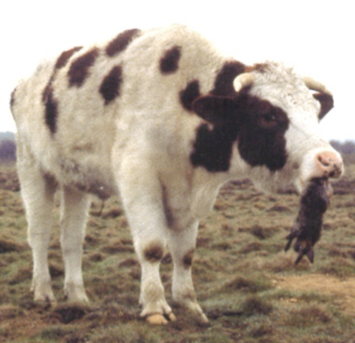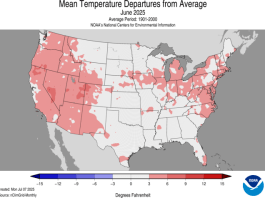
In the first part of his piece Bob Budd talked about how working with natural systems, using more cows, and enjoying “The Glory of Confusion” turned things around at Red Canyon Ranch. In this excerpt from his paper, “Livestock, Wildlife, Plants and Landscapes: Putting It All Together (Lessons from Red Canyon Ranch),” he describes the importance of understanding the behavior of his livestock so that he can make it easier for them to help him meet his goals. Here’s what he’s learned about his four-footed colleagues and how to get along with them.
Absolutely critical to making changes to the landscape is an understanding of the animals we use as ecological and economic tools. So, we have to train the cattle, and they us.
By watching and listening to many people, we have found that we can move a lot of cattle, with a few people, MOST of the time. We expect and accept a major screwup once a year from each of us. We could blame the cows, because most of our screw-ups involve cows in some way. However, one recent revelation of mine is that the more people involved in moving livestock, the better chance you will have some large-scale mess.
We are pretty gentle with our cattle. We do not own a hotshot or a whip. We have about three sorting sticks, and when we work cattle, we usually don’t use those. We are advocates of the Bud Williams schools because his techniques work. The best testament to the fact that these techniques are valid is the use of the name “Bud Williams” as a verb. It is not uncommon to hear about “Bud Williams-ing” a heifer into the barn, or “putting a little Bud” on a group of cows.
Eat, Sleep, and Chew Your Cud
 These three items pretty well sum up the life of a cow or most other grazing animals. They directly parallel the three requirements of a habitat – food, water, and shelter. Anything we do that affects one of these three requirements can shape behavior. An easy example is water development in uplands, but others include movement of animals to desirable areas at the time they desire to be there. Travis Clyde, our cattle manager, has found that to get cattle to rest and chew their cud in a certain location, he simply needs to move them there after they water, which is highly predictable. (Travis says you can set your watch by them). After they water, he moves them to a shady spot in conifers, or a ridge where the breeze will keep the bugs down. The animals will adapt to this action in about two or three days. If he chooses to move them to a new location, he moves them before watering, and lets them locate on a new water source.
These three items pretty well sum up the life of a cow or most other grazing animals. They directly parallel the three requirements of a habitat – food, water, and shelter. Anything we do that affects one of these three requirements can shape behavior. An easy example is water development in uplands, but others include movement of animals to desirable areas at the time they desire to be there. Travis Clyde, our cattle manager, has found that to get cattle to rest and chew their cud in a certain location, he simply needs to move them there after they water, which is highly predictable. (Travis says you can set your watch by them). After they water, he moves them to a shady spot in conifers, or a ridge where the breeze will keep the bugs down. The animals will adapt to this action in about two or three days. If he chooses to move them to a new location, he moves them before watering, and lets them locate on a new water source.
The Buffet Lunch Theory
Cows never order and eat a single meal. They are constantly at the buffet line making choices; choosing differently at different times of year. As a result, we can shape the landscape by managing the time of grazing. We have begun to manage cheatgrass by grazing in early spring, [and we move cattle] as soon as we begin to see the desired perennial grasses elevating. This has led to a short-term increase in western wheatgrass and needlegrasses on that range. It may or may not decrease the amount of cheatgrass, but that is a minor concern.
Our goal is abundant native perennials. The same approach works well in riparian areas, where the animals are anxious to eat green grass in the spring. They are used to clean up old feed and defoliate grasses that may compete with new willow sprouts in these lush areas. By removing rapidly growing brome (until woody plants, sedges and other desirables are elevated) we are able to use the animal behavior and dietary preference to move our landscape in a direction we desire.
Ms. Bovine, Your Child Is at the Front Register
 Instead of attacking a herd of cattle in order to move them, we spend a great deal of time riding through them, opening gates in advance, and pairing them up before and after movement. Most “wrecks” occur because animals are not ready to move. We move a lot of cattle in the middle of the day or the evening, which is not the “cowboy way”. However, if you watch a cow with her calf, she will step out and walk. A mother without her calf will drag back, and eventually run back, taking most of the herd with her. This behavioral trait cannot be denied, and is even seen in human mothers in large department stores when their children have wandered off.
Instead of attacking a herd of cattle in order to move them, we spend a great deal of time riding through them, opening gates in advance, and pairing them up before and after movement. Most “wrecks” occur because animals are not ready to move. We move a lot of cattle in the middle of the day or the evening, which is not the “cowboy way”. However, if you watch a cow with her calf, she will step out and walk. A mother without her calf will drag back, and eventually run back, taking most of the herd with her. This behavioral trait cannot be denied, and is even seen in human mothers in large department stores when their children have wandered off.
When we reach the place we want animals to stay, they are paired before being let out of the bunch, at which time they can go freely to feed, water, or lay down. Before long, the cows seek out their calves and are allowed to leave. By fall when we ship, more than half of the cows will be worked with their calves at their sides.
Head ‘Em Up and Leave ‘Em Be
We have found over time that even if we do a really great job of scaring a herd of cattle from one pasture to the next, we will always have to “backride” the pasture. We also know that two or three of us can move 300 to 400 animals with ease. Planned grazing and daily monitoring of utilization (by ocular estimate) led us to moving cattle over a period of days, instead of a single gather. This practice has several benefits for us. First, it reduces the amount of labor required to move a large number of cattle. In addition, we are able to gather a portion of the pasture which may be more heavily utilized, or where we may desire more or less use. By leaving animals in areas where utilization is more difficult to achieve, we can “gain grass” while not overusing key areas or areas with different management objectives. Lastly, animals which are moving happily (paired up, not confined, and at a pace and direction they choose), will draw other animals to them. This is pure Bud Williams, and it works astoundingly well. Cattle moving freely in the general direction we want to go will get there much quicker and with less stress than animals being forced to follow a road or human route. They will often run, if given the freedom to choose their direction. It may be more important to look behind us when moving cattle than ahead so we can confirm that we are moving away from the area we want to leave, without worrying about the direction we will take to get to the next pasture.
“Vaya Con Dios”, You Old Rip

I have known a few cows who were a bit cranky and I have been kicked, gored or chased by several others who were not. I have also known some cows who were poor mothers, constantly searching for their calf, and producing little milk while growing fat as sows. The reason I speak in the past tense, is that those cows have all become either someone else’s problem, or burger. Landscape management being part of the goal, it only takes a handful of cows to make the process less than optimal. We call these “culls.” In analyzing these cull cows some will raise a good calf on irrigated meadows, or in riparian areas, but most bring back an “average” calf. The reasons are fairly simple – a cow staying in a grazed out area all summer is not going to produce on a par with a cow constantly on fresh forage. To the converse, the cows which produce our heaviest calves are rarely seen during the summer, unless you are riding rimrocks. This is learned behavior. Over time, the same cattle, including mothers and daughters, will forage in the same manner on the same parts of the pasture.
Why Does a Cow Dog Bark?

Travis asked this question one morning, and took me by surprise, something he likes to do. His answer was very simple – “a cow dog barks for the same reason a human being yells at cattle – they are frustrated.” This was a revelation for me, and it taught me a lot; most of all, the notion that as our yelling and the dog’s barking increases, the less chance we have of working cattle successfully. We strive to handle animals with a minimum of stress, to them and to us, and that can be directly measured in decibels. If the cattle are quiet, they will be moving. If the dogs are quiet, the cattle will be moving in the right direction. If the humans are quiet, chances are great that the other two will occur at the same time.




